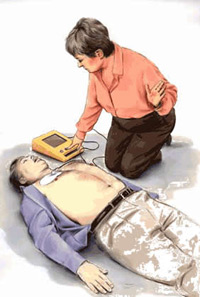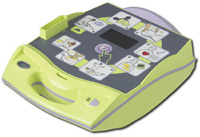What is Cardiac Arrest
 Every minute of every day, sudden cardiac arrest (which often leads to heart attack) claims another victim. A heart attack occurs when the arteries that supply blood to the heart become blocked, the flow of blood which carries oxygen to the heart is slowed or stopped, and the muscle fibers contract chaotically rather than in synch with each other as they normally do.
Every minute of every day, sudden cardiac arrest (which often leads to heart attack) claims another victim. A heart attack occurs when the arteries that supply blood to the heart become blocked, the flow of blood which carries oxygen to the heart is slowed or stopped, and the muscle fibers contract chaotically rather than in synch with each other as they normally do.
Cardiac Victims
The sudden and live-threatening onset of a chaotic and unproductive heart rhythm — claims more than 350,000 lives outside of the hospital annually, with a national survival rate of only five percent. Published studies have proven that early defibrillation, within the first few minutes of cardiac arrest, can save up to 50 percent of victims. The American Heart Association has also stated that each minute of delay in delivering a defibrillation shock to a cardiac arrest victim reduces the chance of survival by 10 percent.
How defibrillators work
Manual defibrillators work by giving the heart a controlled electric shock, forcing all the heart muscles to contract at once, and, hopefully jolting it back into a regular rhythm. Historically, only trained medical professionals were able to interpret the heart rhythms on manual defibrillator devices. However, today’s new Automated External Defibrillators (AEDs) use embedded computer chips to analyze the rhythms instantly and accurately, making it possible for non-medical professionals to administer the same vital service without risking an accidental shock.
 The answer to the problem of how to get timely, lifesaving defibrillation to cardiac arrest victims as soon as possible lies with the AED. As the name implies, the AED is an automatic device capable of automatically recognizing a heart rhythm that requires a shock. It can charge itself and prompt the rescuer to deliver a shock to the victim by pressing a button. AED’s are simple to operate and extremely reliable when used properly. AED’s analyze the victims heart rhythm before several times before identifying it as a shockable rhythm. Because of the need to administer the AED quickly, it is advantageous to have AEDs available in locations where people may suffer sudden cardiac arrest. You may contact the Emergency Medical Services (EMS) Division with any AED questions at 208-7351 or fax at 208-5813.
The answer to the problem of how to get timely, lifesaving defibrillation to cardiac arrest victims as soon as possible lies with the AED. As the name implies, the AED is an automatic device capable of automatically recognizing a heart rhythm that requires a shock. It can charge itself and prompt the rescuer to deliver a shock to the victim by pressing a button. AED’s are simple to operate and extremely reliable when used properly. AED’s analyze the victims heart rhythm before several times before identifying it as a shockable rhythm. Because of the need to administer the AED quickly, it is advantageous to have AEDs available in locations where people may suffer sudden cardiac arrest. You may contact the Emergency Medical Services (EMS) Division with any AED questions at 208-7351 or fax at 208-5813.
